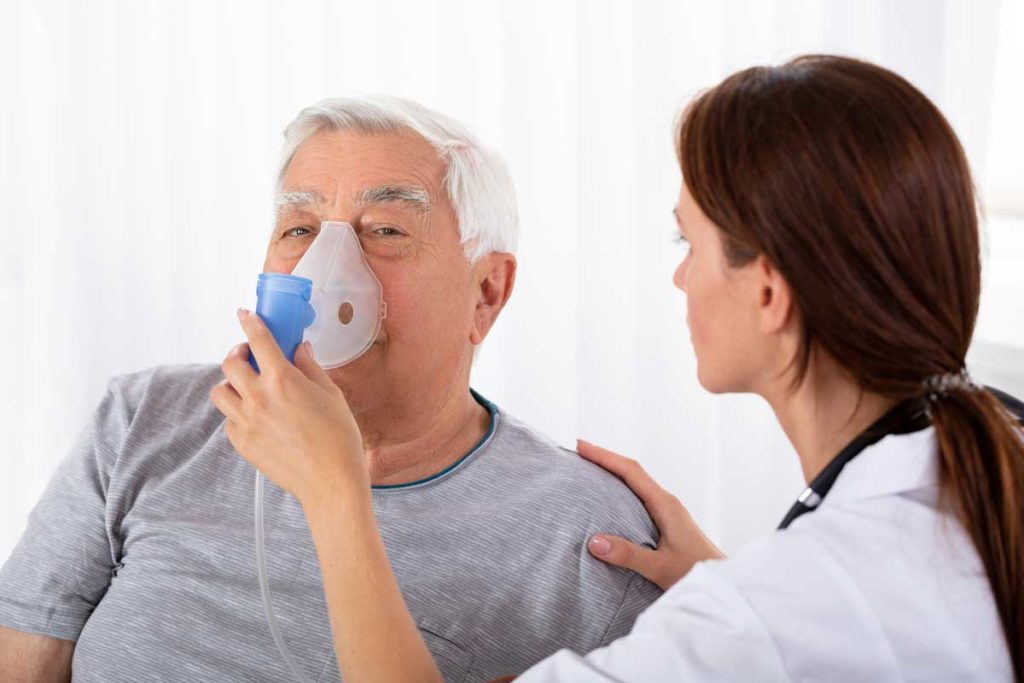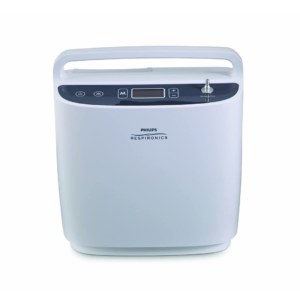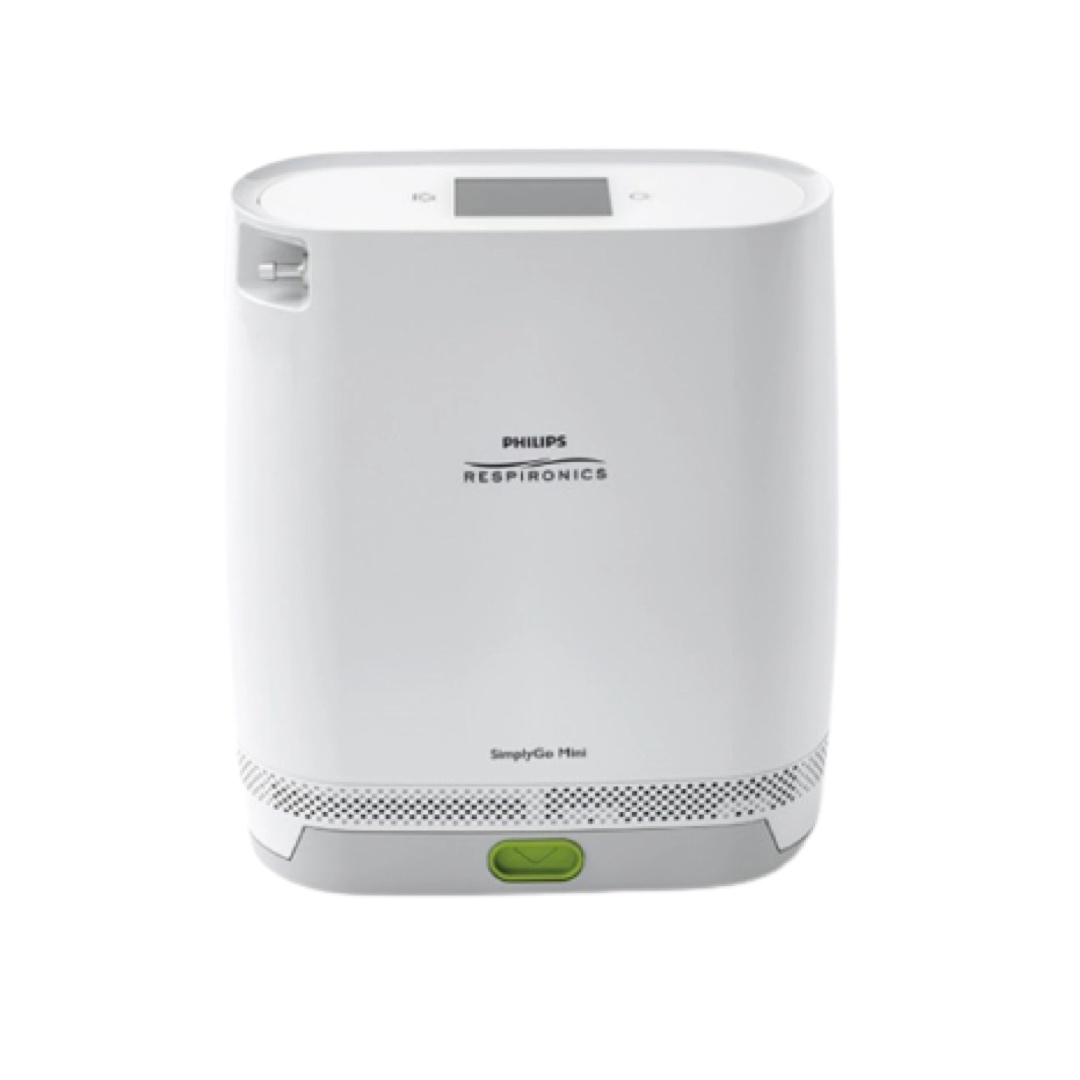Philips Respironics Oxygen Concentrators Review
AgingInPlace.org keeps our resources free by working as an affiliate partner with some companies mentioned on our site. These partnerships or the commission we may earn do not affect our opinions or evaluations of the products we mention. Our reviews are solely based on our research methodology and from input from our AgingInPlace.org Advisory Board. Learn more about our ad policies.
Philips Respironics Oxygen Concentrators Rev...
Products carousel
Key Takeaways
- A portable oxygen concentrator can meet the needs of active individuals, travelers, and anyone who wants the freedom of mobility while using supplemental oxygen.
- The Philips SimplyGo and SimplyGo Mini are two portable oxygen machines that are lightweight and easy to use.
- Both machines come with a variety of accessories and offer a battery life that ranges from three hours to nine hours.
Often associated with the Sonicare toothbrush, the Philips brand is known for much more than just dental hygiene products. The company has been innovating since 1891 and produces a variety of health care products, including breathing and respiratory devices like oxygen concentrators. Philips produces four oxygen concentrators—two home oxygen concentrators and two portable oxygen concentrators (POCs).
While necessary for some, home oxygen concentrators are often larger, stationary machines that offer supplemental oxygen for however often or long you need it. Home oxygen machines are a critical component of therapy for those with acute and chronic lung disease, including asthma, COPD, lung cancer, and COVID-19. While there are several technologies available to deliver home oxygen, portable oxygen concentrators remain highly used because they don’t need refills, they’re easy to use, and they’re portable. Out of its four oxygen concentrator models, Philips makes two POCs: the SimplyGo and the SimplyGo Mini.

POCs give older adults who require supplemental oxygen access to oxygen on the go, so that they can live fuller, more active lives. According to the FDA, breathing in high concentrations of oxygen may damage your lungs. However, not getting enough oxygen into your bloodstream (called hypoxemia) is also dangerous and can damage the heart, brain, and other organs. POCs work by taking in air from the room and filtering out the nitrogen, providing more oxygen needed for those who require oxygen therapy.
“Oxygen from POCs is usually enough to support the needs of seniors during casual, everyday movements throughout their homes or care facilities,” said Nancy Mitchell, a registered nurse and senior care expert at Assisted Living Center. “This is often invaluable to patients who would otherwise be short of breath after taking a couple of steps. In a more literal sense, the wheels on the POC make it easier for older adults to move about while carrying (or gliding) their additional oxygen supply.”
If you’re considering a Philips portable oxygen concentrator, we’ve reviewed and compared the two models so you can choose the right one for you.
Portable Oxygen Concentrator Models by Philips Respironics
Providing versatility for varying oxygen delivery needs, the Philips SimplyGo model offers two different oxygen delivery modes: continuous flow and pulse flow—both of which can be changed with the tap of a button. A pulse device delivers oxygen in bursts, or boluses, when you inhale. Pulse flow oxygen delivery requires a smaller motor, less battery power, and a smaller internal reservoir, allowing pulse flow devices to be incredibly small and efficient. Continuous flow means that the supplemental oxygen is delivered at a steady rate, no matter your breathing pattern. The SimplyGo also offers a sleep function that’s delivered at a pulse flow. This makes the oxygen delivery gentler, so that it’s more comfortable while sleeping.
This POC can deliver up to 2 liters of continuous flow oxygen per minute or up to 6 liters of pulse oxygen per minute, which makes it as powerful as a home oxygen concentrator, but thanks to its small size and battery, it’s also a portable device.
Philips has also run a variety of tests on the SimplyGo to ensure that it can handle extreme impacts, vibrations, and temperatures, including withstanding continued activity at 10,000 feet of elevation.
The SimplyGo comes with a sleek carrying case that looks like a nice, tan travel bag, with an additionally smaller bag for all the accessories. There’s also a foldable cart that comes with it, so you don’t have to carry it.
Warranty: There is a three-year manufacturer’s warranty on the SimplyGo unit and a 90-day warranty on accessories.
Accessories Included:
- Standard rechargeable battery
- Carrying case
- Carry cart
- AC/DC charger
- Nasal cannula
- Accessory bag
SimplyGo Model Details
| Oxygen output/ Flow rate | Weight | Size | Noise leve | Battery life | Flow types | MSRP Price | FAA- approval |
|---|---|---|---|---|---|---|---|
| 12 ml/min–2 l/min | 10 pounds with battery | 11.4 by 10 by 6 inches | 43 decibels | 0.9–3.4 hours | Continuous Pulse | $3,295 |
| Oxygen output/ Flow rate | ||||||||||||||||||||||||||||||||||||||||||||||||||||||||||||||||||||||||||||||||||||||||||||||||||||||||||
| 12 ml/min–2 l/min | Weight | 10 pounds with battery | Size | 11.4 by 10 by 6 inches | Noise leve | 43 decibels | Battery life | 0.9–3.4 hours | Flow types | Continuous Pulse | MSRP Price | $3,295 | FAA- approval |
|---|
Small, portable, tank-free, and with a battery life of up to nine hours, this machine may be what you need to stay active while taking care of your oxygen needs. In fact, the CDC states that it’s best for older adults to move more and sit less throughout the day, which can be tough to do if you require oxygen and it’s not portable.
Like the SimplyGo, the Mini has also undergone a variety of tests to ensure that this oxygen concentrator can withstand extreme temperatures, vibrations, and impacts. Couple this with its smaller, lightweight design and the SimplyGo Mini POC is ideal for those who like to be active.
However, the SimplyGo Mini only offers pulse flow, so if you require continuous flow, you should go with the standard SimplyGo.
This device comes with a dark brown or black carrying case that can be worn like a purse, making it easy to bring along with you wherever you go. There’s an extra smaller carrying case for all its accessories.
Warranty: There is a three-year manufacturer’s warranty on the SimplyGo Mini unit and a 90-day warranty on accessories.
Accessories Included:
- Standard rechargeable battery
- Carrying case and shoulder strap
- AC/DC charger
- Nasal cannula
- Accessory bag
SimplyGo Mini Model Details
| Oxygen output/ Flow rate | Weight | Size | Noise level | Battery life | Flow types | MSRP Price | FAA- approval |
|---|---|---|---|---|---|---|---|
| 1,000 ml/min | 5 pounds with battery | 9.4 by 8.3 by 3.6 inches with the battery | 43 decibels | 6 hours at setting 1 and 4.5 hours at setting 2 | Pulse | $2,995 |
| Oxygen output/ Flow rate | |||||||||||||||||||||||||||||||||||||||||||||||||||||||||||||||||||||||||
| 1,000 ml/min | Weight | 5 pounds with battery | Size | 9.4 by 8.3 by 3.6 inches with the battery | Noise level | 43 decibels | Battery life | 6 hours at setting 1 and 4.5 hours at setting 2 | Flow types | Pulse | MSRP Price | $2,995 | FAA- approval |
|---|
Other Philips Models
In comparison to the newer models, the Respironics EverGo Portable Concentrator, which has been discontinued but can still be purchased through available inventory online, delivers oxygen through a pulse flow and has a four-hour battery life. The machine weighs about 9 pounds with one battery. If you want longer usage, you can buy another battery to give you another four hours of use. It has six oxygen flow settings and offers a maximum oxygen output of 1,050 milliliters of oxygen per minute, while still being small enough to carry and travel with. It rings in at 43 decibels for noise level, which is the same as the SimplyGo machines.
Philips also offers two home oxygen concentrators—the EverFlo and Millennium M10 home oxygen systems. These two machines aren’t as small, light, or portable as the SimplyGo products. While these oxygen concentrators are both for home use and are highly-rated, they are intended for individuals who require a more constant supply of oxygen and/or at a high rate. Since these machines are bigger and are often run around the clock, they use more electricity than their portable counterparts.
Comparison of Philips Portable Oxygen Concentrators
| Device | Oxygen Output/Flow rate | Weight | Size | Noise level | Battery life | Flow types | MSRP Price |
|---|---|---|---|---|---|---|---|
| SimplyGo | 12 ml/min–2 l/min | 10 pounds with battery | 11.4 by 10 by 6 inches | 43 decibels | 0.9–3.4 hours | Continuous Pulse | $3,295 |
| SimplyGo Mini | 11–50 ml/min | 5 pounds with battery | 9.4 by 8.3 by 3.6 inches | 43 decibels | 4.5–6 hours | Pulse | $2,995 |
| Device | ||||||||||||||||||||||||||||||||
| SimplyGo | Oxygen Output/Flow rate | 12 ml/min–2 l/min | Weight | 10 pounds with battery | Size | 11.4 by 10 by 6 inches | Noise level | 43 decibels | Battery life | 0.9–3.4 hours | Flow types | Continuous Pulse | MSRP Price | $3,295 |
|---|
| SimplyGo Mini | Oxygen Output/Flow rate | 11–50 ml/min | Weight | 5 pounds with battery | Size | 9.4 by 8.3 by 3.6 inches | Noise level | 43 decibels | Battery life | 4.5–6 hours | Flow types | Pulse | MSRP Price | $2,995 |
|---|
Support, Warranty & Trial
Support
The Philips website doesn’t make it easy for you to find how to connect with someone when you have questions about their products. The best way to reach out for support is to call: 800.345.6443. Numerous reviews state that the customer service team is very helpful once you connect with them.
Warranty
The Philips SimplyGo and SimplyGo Mini portable oxygen concentrators both offer a standard three-year manufacturer’s warranty on the unit and a 90-day warranty on accessories.
Trial
All Philips’ oxygen concentrators have a 30-day money-back guarantee with free returns.
Reviews of Philips Respironics Oxygen Concentrators
The majority of consumers who left reviews on retailer sites and third-party review sites prefer the Philips Respironics SimplyGo Mini for its size, lighter weight, and portability. However, if you require continuous oxygen flow, it’s best to go with the Philips Respironics SimplyGo, even though it’s a little heavier (about 5 pounds heavier than the Mini). Individual oxygen needs, including continuous flow versus pulse flow delivery, will be determined by your physician. Your oxygen prescription, combined with personal preferences and lifestyle, will help you narrow down which devices are appropriate for you.
Consumer reviews from the Oxygen Concentrator Store and Oxygen Concentrator Supplies also highlight that setting up the oxygen concentrator is easy and quick. Many users also attest to feeling better within 72 hours of having their devices up and running.
A few downsides that have been mentioned among reviews is that the devices are a bit louder at different modes than they thought and that the battery life doesn’t last as long as you shift through the flow modes. Several reviews have also stated that the Philips SimplyGo and Mini are higher in price than other models.
Overall, the Philips Respironics SimplyGo and SimplyGo Mini have been rated as two well-made, portable, durable, and easy-to-use oxygen concentrators.
Why an Oxygen Concentrator is Worth It?

Being mobile, staying active, and breathing well are all things we take for granted until it’s hard to do them. A portable oxygen concentrator may seem frustrating or daunting, but with today’s technology, it doesn’t have to be. You don’t have to stop living your life because you need extra oxygen. You can now find a machine that meets your needs while being portable, light, travel-friendly, and attractive.
Other Portable Oxygen Concentrators We Recommend
Other brands that we recommend include:
Why Trust Us?
The AgingInPlace.org team researches, analyzes, and tests health products to help older adults make better decisions as they age. For portable oxygen concentrators, we’ve reviewed 11 manufacturers and 22 individual models on the market today to offer you our top picks.
We’re committed to bringing you the most accurate information, based on our in-depth research. Below you’ll find a description of our methodology for reviewing portable oxygen concentrators:
- Spent hundreds of hours researching POC brands and models
- Consulted medical experts and journals
- Studied the user experience through insight from professionals, user reviews, and third-party research
To provide the most fair and objective reviews and comparisons, we use a mathematical formula to score each model based on the following considerations:
- Unit weight
- Battery life
- Range of settings
- Price
- Battery recharge time
- Warranty
- Oxygen delivery method
Our team monitors and regularly updates information to ensure relevance and reliability throughout all of our content. Many products and services featured on AgingInPlace.org will play a crucial role in your daily life. As these products should help enhance aging at home, we work to uncover as much as possible about the products and services we review. We also consult occupational therapists, audiologists, geriatricians, respiratory therapists, professional adult caregivers, and other experts in the field to ensure we’re providing the most accurate, helpful information.
Frequently Asked Questions
-
Yes, Philips Respironics is the name of the division within Philips that creates breathing devices such as oxygen concentrators.
-
In Pittsburgh, Pa.
-
Philips voluntarily recalled a variety of CPAP and BiPAP devices and ventilators as of June 31, 2021. Click here for the full list.
-
The Everflo is a home oxygen concentrator by Philips. Depending where you buy it from, you could pay anywhere from $850–$1,400.
-
No, the SimplyGo Mini only offers pulse flow, also known as intermittent flow. The SimplyGo offers both pulse and continuous flow capabilities.
WRITTEN BY
Kelsey Sanders is a freelance writer, editor, ghostwriter, and book coach based in West Michigan. When she’s not working in the world of words, she owns a wellness company called ThriveWell, where she works with individuals and small local businesses to create customized wellness plans. She’s also a new mom and navigating working from home with a little one.
View AuthorMEDICALLY REVIEWED BY
Elizabeth has been a respiratory therapist since 1983 and remains licensed in the state of New York. Her experience in respiratory care includes routine and critical care in the hospital setting outpatient and at home equipment modalities and management and use of home ventilators, CPAP, BiPAP, apnea monitor, nebulizer, and other respiratory-related equipment.
View Reviewer- Characterization of Prescription Patterns and Estimated Costs for Use of Oxygen Concentrators for Home Oxygen Therapy in the US | JAMA Network
- How Much Physical Activity Do Older Adults Need? | CDC
- Pulse Oximeters and Oxygen Concentrators: What to Know About At-Home Oxygen Therapy | FDA
- What is an Oxygen Concentrator | WebMD
Do you want to cite this page? Use our ready-made cite template.




